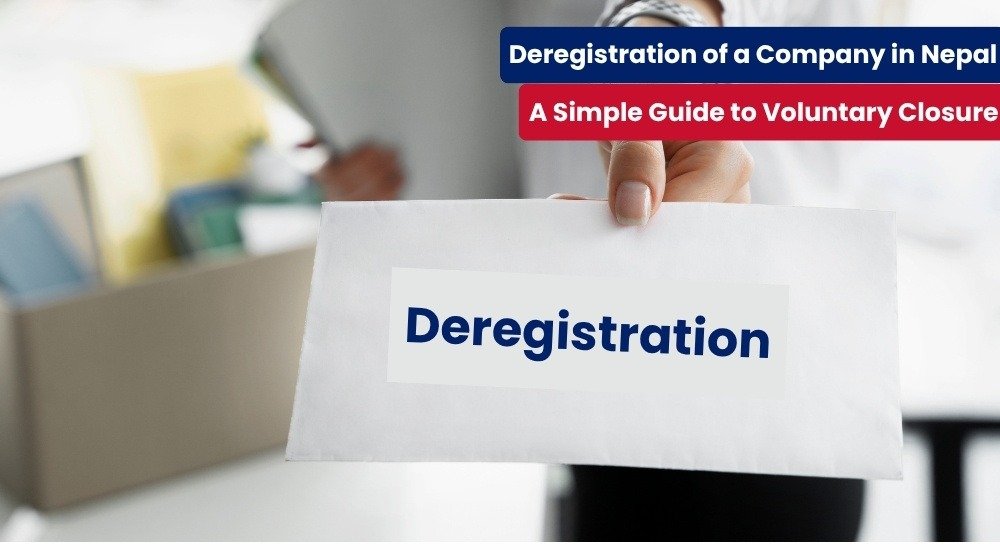In Nepal, a company may choose to deregister (or voluntarily close) if it has not been operational and hasn’t conducted any activities since its registration. Deregistration differs from liquidation, as it allows companies that have never conducted business or incurred liabilities to cancel their registration and officially cease to exist. This process, known as “Darta Khareji” in Nepal, is a simplified alternative to the voluntary liquidation process.
In this article, we will explore the steps involved in deregistering a company in Nepal, explain the differences between voluntary liquidation and deregistration, and provide a detailed guide on the eligibility and process of voluntary closure without liquidation.
What is the Deregistration of a Company?
Deregistration refers to the cancellation of a company’s registration with the Office of the Company Registrar (OCR) in Nepal.
A company can choose to deregister if it has never operated or carried out any business activities since its formation.
This means the company has not submitted any compliance documents, including quarterly reports or annual filings, to the OCR.
Deregistration is a simpler process for companies with no operations, assets, or liabilities.
The deregistration process is particularly useful for companies that were formed but did not conduct any business, or that have been inactive for an extended period.
What are the Differences Between Deregistration and Voluntary Liquidation?
While both processes lead to a company’s cessation of existence, deregistration and voluntary liquidation have distinct purposes and steps.
Here are the key differences:
| S.N. | Voluntary Liquidation | Deregistration of a Company |
|---|---|---|
| 1. | A company chooses to liquidate its assets and settle its liabilities. | A company cancels its registration when it has never operated. |
| 2. | Initiated by shareholders or directors to sell assets and settle debts. | Initiated by the promoter, who justifies the inability to commence business. |
| 3. | The company must settle liabilities before liquidation. | No operational activities or liabilities need to be settled. |
| 4. | It may involve a longer process, including asset sales and debt payments. | A simpler process due to the absence of operations or liabilities. |
| 5. | It can be initiated only by the company’s shareholders or directors. | It can be undertaken by the OCR if the company hasn’t been operational. |
While voluntary liquidation involves asset sales and the fulfilment of liabilities, deregistration is a simpler process for companies that were registered but have never engaged in business activities.
What Are the Procedures for the Deregistration of a Company?
If your company in Nepal has never been operational, you can follow the process for voluntary deregistration.
This process includes the following steps:
Passing a Special Resolution
The first step is to pass a special resolution at a shareholder meeting. This resolution declares the company’s intention to deregister due to its non-operation.
The shareholders agree to proceed with the deregistration process, and the resolution is officially submitted to the Office of the Company Registrar (OCR).
Publishing a Notice of Deregistration
Once the resolution is passed, a public notice of the company’s intention to deregister must be published in a national daily newspaper.
This notice informs the public and any interested parties of the company’s closure and the start of the deregistration process.
Letter of Confirmation from Auditors
The company must submit a letter of confirmation from its auditors to the OCR. This letter confirms that the company has not conducted any economic activities since its registration.
It also verifies that the company has no outstanding liabilities or assets.
Confirmation from the Inland Revenue Department (IRD)
The company must obtain confirmation from the Inland Revenue Department (IRD) that it has no tax obligations or pending filings.
This is a necessary step to ensure that the company is fully compliant with tax laws before proceeding with deregistration.
Deregistration at OCR
After completing the previous steps, the company submits an application to the OCR for deregistration.
The application includes the special resolution, public notice, auditor’s confirmation, and the tax clearance from the IRD.
Once OCR approves the application, the company’s registration is officially cancelled.
Closure at the Local Level and IRD
Finally, the company must complete the closure process at the local level. This involves notifying the ward office and the Inland Revenue Office (IRD) that the company has been deregistered.
This step ensures that the company’s closure is recorded at all relevant government agencies.

Deregistration of a Company Without Liquidation
In Nepal, Darta Khareji is the process of voluntarily closing a company without going through the full liquidation procedure.
This process is particularly applicable to companies that have never conducted business and have no assets or liabilities.
Here is the key steps involved in closing a company without liquidation:
To be eligible for this simplified process, the company must meet the following criteria:
- No business activities – The company has not carried out any business or operations since its registration.
- No liabilities or assets – The company has no debts, assets, or ongoing obligations.
- No legal disputes – There are no unresolved contracts, legal disputes, or claims against the company.
- Board Meeting – The company’s Board of Directors must hold a meeting and pass a resolution to close the company voluntarily. This resolution is crucial for initiating the deregistration process.
- Public Notice – The company must publish a closure notice in two newspapers, including one national daily. This is to inform the public about the company’s intention to close and deregister.
- Shareholder Approval – A general meeting of shareholders must formally approve the resolution for closure. This ensures that all stakeholders agree to the voluntary closure.
- Application to OCR – The company submits an application to the OCR, along with the required documents, including the board resolution and shareholder approval.
- Final Publication – Once the OCR approves the closure, a final notice is published in newspapers confirming that the company has been officially deregistered.
What Are the Consequences of Ignoring Company Closure in Nepal?
Failing to close a company in Nepal can result in serious legal and financial repercussions. Here’s what could happen:
Legal Action and Fines
If you neglect to close your company, the government can impose penalties and fines for noncompliance with legal requirements.
If these fines go unpaid, legal action may be taken to recover the amount owed.
Damage to Credit Rating
Failing to close a company can harm your credit rating, making it harder to obtain loans or pursue future business ventures.
Personal Liability for Company Debts
You could become personally liable for the company’s outstanding debts or obligations, putting your personal finances at risk.
Conclusion
Deregistration of a company in Nepal is a straightforward and efficient process for companies that have not engaged in any business activities.
This process allows businesses to cancel their registration without going through the lengthy and complex liquidation process.
By following the necessary steps, such as passing a special resolution, obtaining confirmations from auditors and the IRD, and publishing public notices, companies can quickly and legally dissolve their existence.
The voluntary deregistration process is an ideal solution for companies that have never operated, ensuring compliance with Nepalese laws while relieving them of any future obligations.
As a simpler alternative to voluntary liquidation, Darta Khareji is a great option for businesses that were registered but never conducted business, providing them with a clear path to an official closure without further legal or financial burden.





